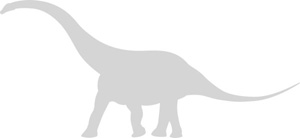Every month, 100,000 readers use the Dinosaur Database, but we receive no support from you. Developing and updating the database requires a lot of work. If you want it to remain open and be updated, please support us via the "Buy us a coffee" button available on every page or via the Support page.
Dinosaur: Abdarainurus barsboldi

| Length*: | 22.5 m | 73.8 ft |
| Weight*: | 33 t | 72,752 lb |
*The largest known specimen
Period
Epoch: Late Cretaceous
Years: 85–72.1 Ma
Details
Status: valid
Author: Averianov & Lopatin
Year: 2020
Distribution
Area: Asia
Country: Mongolia
Region: Ömnögovi
Formation: Alagteeg
Description
Abdarainurus barsboldi
Abdarainurus barsboldi is a lesser-known genus of sauropod dinosaur that lived during the Late Cretaceous period, around 85–72 million years ago. Its remains were discovered in the Gobi Desert of Mongolia, in the Barun Goyot Formation. The genus name “Abdarainurus” is derived from “Abdrant Nuur,” a locality in Mongolia where the fossils were found, and “urus,” meaning “tail” in Latin, while the species name “barsboldi” honors the renowned Mongolian paleontologist Dr. Rinchen Barsbold. As a member of the titanosaur family, Abdarainurus adds to our understanding of the diversity of sauropods that inhabited Asia during the Late Cretaceous.
Physical Characteristics
Abdarainurus barsboldi was a titanosaur, estimated to have reached lengths of about 25 m (82 ft). Unlike many other titanosaurs, much of what is known about Abdarainurus comes from its distinctive caudal (tail) vertebrae. These vertebrae are notable for their unique morphology, particularly the elongated, rod-like neural spines, which differ from those of other sauropods. This unusual tail structure suggests it had a distinct locomotion or tail function, potentially used for display, communication, or balance. The rest of its body was likely similar to other titanosaurs, with a long neck, a relatively small head, and a massive, barrel-shaped torso. Its limbs were thick and columnar, designed to support its heavy, herbivorous frame.
Diet and Feeding Habits
As a herbivore, Abdarainurus barsboldi would have fed on a wide range of plant materials, including ferns, cycads, conifers, and early flowering plants. Its peg-like teeth were adapted for stripping leaves rather than chewing, which is characteristic of sauropods. It likely used its long neck to reach vegetation at different heights, allowing it to access food sources that smaller herbivores could not. The large gut of Abdarainurus would have been adapted for fermenting and digesting large quantities of plant material, using bacterial fermentation to break down tough cellulose in plants. This slow digestive process enabled it to extract the maximum nutrients from its food, supporting its large size.
Habitat and Distribution
Abdarainurus barsboldi lived in what is now the Gobi Desert of Mongolia, a region that, during the Late Cretaceous, was part of a diverse and dynamic ecosystem. The Barun Goyot Formation, where its fossils were discovered, suggests a habitat consisting of arid to semi-arid conditions with seasonal rivers and floodplains. This environment supported a variety of plant life and hosted a wide range of other dinosaurs, including theropods, ceratopsians, and ankylosaurs. The presence of Abdarainurus in this region highlights the adaptability of titanosaurs to different environments, from dense forests to more open, dry habitats.
Behavior and Social Structure
The behavior of Abdarainurus barsboldi remains speculative due to the limited fossil record, but it likely exhibited some behaviors common to other sauropods. It may have lived in herds, which could provide protection against predators and enhance foraging efficiency. The unusual tail morphology of Abdarainurus could suggest a role in communication within the herd, potentially through visual signals or sound production. Like other titanosaurs, it might have migrated seasonally to find sufficient food and water resources, traveling across large areas in search of suitable habitats.
Discovery and Research
Abdarainurus barsboldi was first described in 2020 by a team of paleontologists led by Alexander Averianov and Alexey Lopatin. The fossils, consisting mainly of caudal vertebrae, were found in the Abdrant Nuur locality in the Barun Goyot Formation of Mongolia. The unique features of these vertebrae set Abdarainurus apart from other known titanosaurs, leading to its identification as a new genus and species. As one of the more recent discoveries among Asian titanosaurs, Abdarainurus provides valuable insights into the evolution and diversity of sauropods in Asia during the Late Cretaceous. Further research and potential future discoveries may reveal more about its anatomy, behavior, and ecological role.
Significance and Interesting Facts
The discovery of Abdarainurus barsboldi is significant because it represents a unique branch of the titanosaur lineage with distinct anatomical features not seen in other sauropods. Its unusual tail morphology contributes to our understanding of the evolutionary diversity within the Titanosauria group and raises questions about the ecological roles and behaviors of sauropods. As one of the few known sauropods from the Late Cretaceous of Mongolia, Abdarainurus helps fill a gap in the fossil record and provides insights into the distribution of titanosaurs in Asia. The ongoing study of this dinosaur may further illuminate the adaptations that allowed titanosaurs to thrive in a range of environments across the ancient world.
Locations
Sources
Material: Nine caudal vertebrae and chevrons.
References: Alexander O. Averianov & Alexey V. Lopatin (2020). An unusual new sauropod dinosaur from the Late Cretaceous of Mongolia.




